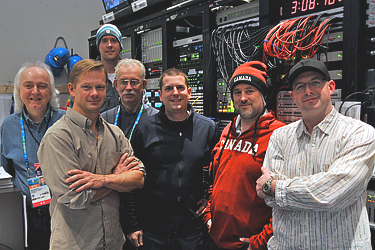NBC Refines Olympics Comms
VANCOUVER
On paper, most would say that NBC didn’t reinvent intercom communications for the 2010 Winter Olympics in Vancouver. We’re still using RTS ADAM intercom matrix and panels. We’re still using RVON (RTS Voice Over Network) IP based comms at all of our venues. In fact, a good portion of the hardware we’ve used in the past was unboxed and used again in Vancouver.

(L to R): NBC Olympics Comms Crew: Bob Gilmartin, Tony Kremer, Kevin Shea, Vic Main, John Pastore, Sean McKinnon, and Rick Hayes What we have done is scaled the size of our system down considerably from the last time it was used in Beijing for the 2008 Summer Olympics. We moved from a three-frame ADAM matrix consisting of 384 AIO ports and 184 RVON ports to a two-frame matrix with 320 AIO and 160 RVON ports. We also scaled back on telephone interfaces; down from 36 TIF-4000 units in Beijing to 24.
WHAT WORKED, WHAT DIDN’T
There are a number of reasons for this. Mostly, it had to do with it being a winter Olympics, which tends to be smaller in terms of venues presence and production size. But for me, this Olympics was all about refining without radically redesigning. With the time I spent managing communications for NBC in Beijing, I had the opportunity to learn what worked, what didn’t and what needed improvement. Vancouver was a chance to apply some of those changes and create a better, leaner, meaner workflow for everyone.
I would be lying if I said we didn’t make any changes or improvements in hardware. This time around we moved from a DBX (Dual-Bus) expanded ADAM matrix to the new TBX (Tri-Bus) expanded ADAM matrix. TBX along with Master Controllers in each ADAM frame allowed both frames to run independently of each other if communication between them was lost. This is a wonderful failsafe but did require a bit of thought in how we configured our port assignments to take advantage of this split frame scenario.
In addition to TBX, we introduced the all-new RTS KP32 CLD color LCD intercom panels. With 196 CLD installations in Vancouver, the NBC Olympics became one of the largest CLD installations to date. What made these panels a must for us was the 8 character alpha displays and color-coding of functions.
In the past, being limited to only 4 character alphas and monotone displays required a lot of creative intercom resource naming. With hundreds of users, party lines, IFBs, etc. between the IBC (International Broadcast Center), Vancouver venues and our U.S.-based facilities, you can imagine the difficulty in naming intercom resources logically. That’s where the new CLD panels made their mark for us. To help identify intercom alphas, the CLD allows the user to assign colors to functions. What that means is that instead of everything on an intercom panel being the same color, IFBs are now red, panel users are blue, party lines are Green, camera ISOs are yellow.
This paired with 8 character alphas created endless possibilities and made the KP32 CLD intercom panel priceless for a production of this size.
Some additional hardware changes included RVON-16 cards, which allowed us to fit twice the number of ports into the same space as the RVON-8 cards we used in Beijing. We also used PAP-32 IFB Assignment panels in our audio control room as well as the Communications office. With the number of IFB changes being made day-to-day, these panels helped manage these changes quickly and efficiently without the need to send and re-send changes via AZEdit (RTS ADAM programming software interface).
SMALLER DIDN’T MEAN EASIER
Earlier I mentioned that this Olympics was scaled down and smaller than in the past, but that doesn’t mean it was any easier. Vancouver proved to be more complex than Beijing and required the Comms team to push our intercom system to its limits and it performed flawlessly.
One challenge included the introduction of NBC’s cousin, Universal Sports. Universal’s production started in Westlake, Calif., where their show was cut from—but via RVON—ended at a roof-top set at the IBC. We provided three intercom positions in Westlake and three positions at the Vancouver set. In addition, we created 4-wire party lines between our RTS intercom system and their Riedel system as well as wet Party Lines, wet IFBs and program audio to their set on the roof. In a nutshell, we built Universal Sports a full remote on the roof of the IBC and have RVON to thank for it.
Another challenge was the downsizing of production at the IBC. In Beijing, we supported two studios, each with its own control room and audio room. In Vancouver, we only had one studio and its supporting parts to maintain. While this sounds easier than in the past, it proved to be more difficult do to the small, if any, turn-around times between Day Time/Prime Time and Late Night productions in the studio and control room. It required very quick and precise intercom changes between productions with no room for error. Thankfully NBC has built the best Comms team in business to manage it.
So with London on the horizon, it will be interesting to see what kind of changes and refinements it will bring. I welcome the challenge and I’m eager to reunite with some of the best men and women in television.
John Pastore is a communications manager with NBC Olympics
The professional video industry's #1 source for news, trends and product and tech information. Sign up below.
